机器学习分类模型代码实现:KNN, LDA, NB, LR, CART, SVM, RF, XGBOOST, LightGBDT
数据预处理
1 | import numpy as np |
2 | import pandas as pd |
3 | import matplotlib.pyplot as plt |
4 | import seaborn as sns |
5 | from sklearn.metrics import classification_report |
6 | from sklearn import metrics |
7 | from sklearn.preprocessing import StandardScaler |
8 | from sklearn.model_selection import train_test_split, cross_val_score, GridSearchCV |
9 | from sklearn.metrics import confusion_matrix, accuracy_score, roc_curve, auc |
10 | plt.rcParams['font.sans-serif']=['SimHei'] |
11 | plt.rcParams['axes.unicode_minus']=False |
12 | plt.style.use('ggplot') |
1 | df = pd.read_table('australian.dat',sep=' ', header=None) |
2 | df.columns = ['A1', 'A2', 'A3', 'A4', 'A5', 'A6', 'A7', 'A8', 'A9', 'A10', 'A11', 'A12', 'A13', 'A14', 'Default'] |
分类变量处理:哑变量
1categorical_columns = ['A1', 'A4', 'A5', 'A6', 'A8', 'A9', 'A11', 'A12']2df = pd.get_dummies(df, columns = categorical_columns)3df.describe()A2 A3 A7 A10 A13 A14 Default A1_0 A1_1 A4_1 ... A6_9 A8_0 A8_1 A9_0 A9_1 A11_0 A11_1 A12_1 A12_2 A12_3 count 690.000000 690.000000 690.000000 690.00000 690.000000 690.000000 690.000000 690.000000 690.000000 690.000000 ... 690.000000 690.000000 690.000000 690.000000 690.000000 690.000000 690.000000 690.000000 690.000000 690.000000 mean 31.568203 4.758725 2.223406 2.40000 184.014493 1018.385507 0.444928 0.321739 0.678261 0.236232 ... 0.011594 0.476812 0.523188 0.572464 0.427536 0.542029 0.457971 0.082609 0.905797 0.011594 std 11.853273 4.978163 3.346513 4.86294 172.159274 5210.102598 0.497318 0.467482 0.467482 0.425074 ... 0.107128 0.499824 0.499824 0.495080 0.495080 0.498592 0.498592 0.275490 0.292323 0.107128 min 13.750000 0.000000 0.000000 0.00000 0.000000 1.000000 0.000000 0.000000 0.000000 0.000000 ... 0.000000 0.000000 0.000000 0.000000 0.000000 0.000000 0.000000 0.000000 0.000000 0.000000 25% 22.670000 1.000000 0.165000 0.00000 80.000000 1.000000 0.000000 0.000000 0.000000 0.000000 ... 0.000000 0.000000 0.000000 0.000000 0.000000 0.000000 0.000000 0.000000 1.000000 0.000000 50% 28.625000 2.750000 1.000000 0.00000 160.000000 6.000000 0.000000 0.000000 1.000000 0.000000 ... 0.000000 0.000000 1.000000 1.000000 0.000000 1.000000 0.000000 0.000000 1.000000 0.000000 75% 37.707500 7.207500 2.625000 3.00000 272.000000 396.500000 1.000000 1.000000 1.000000 0.000000 ... 0.000000 1.000000 1.000000 1.000000 1.000000 1.000000 1.000000 0.000000 1.000000 0.000000 max 80.250000 28.000000 28.500000 67.00000 2000.000000 100001.000000 1.000000 1.000000 1.000000 1.000000 ... 1.000000 1.000000 1.000000 1.000000 1.000000 1.000000 1.000000 1.000000 1.000000 1.000000 8 rows × 43 columns
连续变量处理:标准化
先划分训练集和测试集,在求训练集的连续变量每一列的方差和均值,用得到的训练集的方差和均值分别对训练集和测试集做标准化1train_df, test_df = train_test_split(df, test_size = 0.3, random_state= 2019)2train_y = train_df.Default3test_y = test_df.Default4train_x = train_df.drop(['Default'], axis = 1)5test_x = test_df.drop(['Default'], axis = 1)1continus_keys = train_x.keys()[:6]2continus_keysIndex([‘A2’, ‘A3’, ‘A7’, ‘A10’, ‘A13’, ‘A14’], dtype=’object’)
1for each in continus_keys:2std,mean = [np.std(train_x[each]),np.mean(train_x[each])]3f = lambda x: (x-mean)/(std)4train_x[each] = train_x[each].apply(f)5test_x[each] = test_x[each].apply(f)训练集和测试集的维度
1test_x.shape,train_x.shape2((207, 42), (483, 42))roc曲线函数和混淆矩阵函数
1def print_roc_curve(test_y, predictions):2false_positive_rate, recall, thresholds = roc_curve(test_y, predictions)3roc_auc = auc(false_positive_rate, recall)4plt.title('Receiver Operating Characteristic (ROC)')5plt.plot(false_positive_rate, recall, 'b', label = 'AUC = %0.3f' %roc_auc)6plt.legend(loc='lower right')7plt.plot([0,1], [0,1], 'r--')8plt.xlim([0.0,1.0])9plt.ylim([0.0,1.0])10plt.ylabel('Recall')11plt.xlabel('Fall-out (1-Specificity)')12plt.show()1def print_confusion_matrix(test_y, predictions):2cm = confusion_matrix(test_y, predictions)3labels = ['No Default', 'Default']4plt.figure(figsize=(8,6))5sns.heatmap(cm,xticklabels=labels, yticklabels=labels, annot=True, fmt='d', cmap="Blues", vmin = 0.2);6plt.title('Confusion Matrix')7plt.ylabel('True Class')8plt.xlabel('Predicted Class')9plt.show()10target_names = ['class 0', 'class 1']11print(classification_report(test_y, predictions, target_names=target_names))12recall = metrics.recall_score(test_y, predictions)13f1 = metrics.f1_score(test_y, predictions)14acc = metrics.accuracy_score(test_y, predictions)15pre = metrics.precision_score(test_y, predictions)16auc = metrics.roc_auc_score(test_y,predictions)17return [recall,pre,acc,f1,auc]
1 | RESULT = {} |
KNN
1 | from sklearn.neighbors import KNeighborsClassifier |
GridSearchCV 为网格搜索, 在训练集上进行10折交叉验证,目的找到最优参数
搜索参数:
k_range:领域大小
p: 距离定义,p=2:欧式距离;p=1:曼哈顿距离
这里距离定义都是用于连续变量,但是数据集中还有分类变量,存在一点不合理,ppt还是别展示,避免被问到
1 | knn = KNeighborsClassifier() |
2 | k_range = list(range(5,15)) |
3 | p = [1,2] |
4 | param_gridknn = dict(n_neighbors = k_range,p=p) |
5 | gridKNN = GridSearchCV(knn, param_gridknn, cv=10, scoring='roc_auc',verbose=1, n_jobs=-1) |
6 | gridKNN.fit(train_x,train_y) |
7 | print('best params are:',str(gridKNN.best_params_)) |
Fitting 10 folds for each of 20 candidates, totalling 200 fits
[Parallel(n_jobs=-1)]: Done 50 tasks | elapsed: 7.4s
best params are: {'n_neighbors': 10, 'p': 1}
[Parallel(n_jobs=-1)]: Done 200 out of 200 | elapsed: 8.6s finished1 | knn = KNeighborsClassifier(n_neighbors=10, p=1) |
2 | knn.fit(train_x, train_y) |
3 | |
4 | predictions_Knn_prob = knn.predict(test_x) |
5 | predictions_Knn_01 = np.where(predictions_Knn_prob > 0.5, 1, 0) |
6 | |
7 | acc_knn = accuracy_score(test_y, predictions_Knn_01) |
8 | print('Overall accuracy of KNN model:', acc_knn) |
9 | |
10 | print_roc_curve(test_y, predictions_Knn_prob) |
11 | r = print_confusion_matrix(test_y, predictions_Knn_01) |
12 | RESULT['KNN'] = r |
Overall accuracy of KNN model: 0.8647342995169082
/usr/local/lib/python3.6/dist-packages/matplotlib/font_manager.py:1241: UserWarning: findfont: Font family ['sans-serif'] not found. Falling back to DejaVu Sans.
(prop.get_family(), self.defaultFamily[fontext]))
/usr/local/lib/python3.6/dist-packages/matplotlib/font_manager.py:1241: UserWarning: findfont: Font family ['sans-serif'] not found. Falling back to DejaVu Sans.
(prop.get_family(), self.defaultFamily[fontext]))
/usr/local/lib/python3.6/dist-packages/matplotlib/font_manager.py:1241: UserWarning: findfont: Font family ['sans-serif'] not found. Falling back to DejaVu Sans.
(prop.get_family(), self.defaultFamily[fontext]))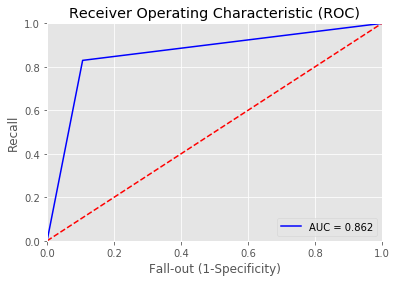
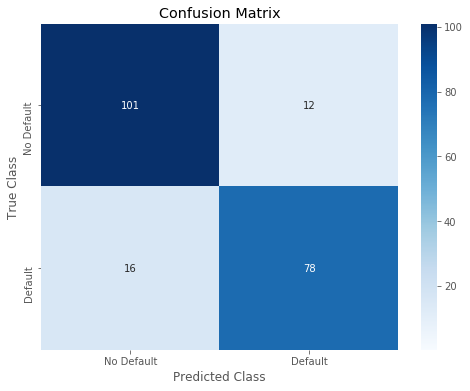
precision recall f1-score support
class 0 0.86 0.89 0.88 113
class 1 0.87 0.83 0.85 94
micro avg 0.86 0.86 0.86 207
macro avg 0.86 0.86 0.86 207
weighted avg 0.86 0.86 0.86 207LDA
1 | from sklearn.discriminant_analysis import LinearDiscriminantAnalysis |
1 | lda = LinearDiscriminantAnalysis() |
2 | lda.fit(train_x, train_y) |
3 | |
4 | predictions_LDA_01 = lda.predict(test_x) |
5 | predictions_LDA_prob = lda.predict_proba(test_x) |
6 | predictions_LDA_prob = predictions_LDA_prob[:,1] |
7 | |
8 | acc_lda = accuracy_score(test_y, predictions_LDA_01) |
9 | print('Overall accuracy of LDA model:', acc_lda) |
10 | |
11 | print_roc_curve(test_y, predictions_LDA_prob) |
12 | r = print_confusion_matrix(test_y, predictions_LDA_01) |
13 | RESULT['LDA'] = r |
Overall accuracy of LDA model: 0.8357487922705314
/usr/local/lib/python3.6/dist-packages/sklearn/discriminant_analysis.py:388: UserWarning: Variables are collinear.
warnings.warn("Variables are collinear.")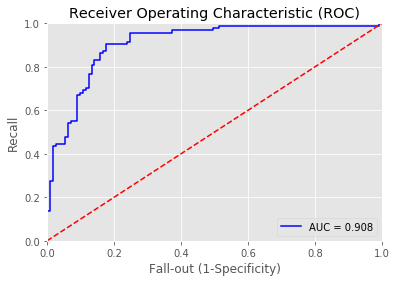
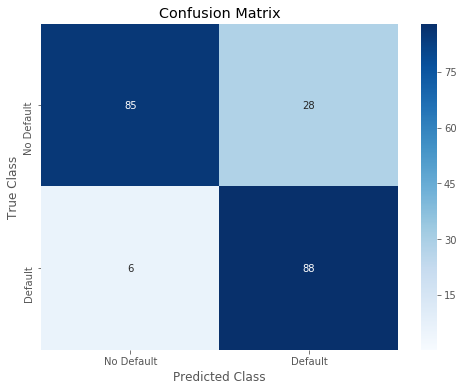
precision recall f1-score support
class 0 0.93 0.75 0.83 113
class 1 0.76 0.94 0.84 94
micro avg 0.84 0.84 0.84 207
macro avg 0.85 0.84 0.84 207
weighted avg 0.85 0.84 0.84 207NB
1 | from sklearn.naive_bayes import BernoulliNB, GaussianNB, MultinomialNB |
GaussianNB就是先验为高斯分布的朴素贝叶斯,
MultinomialNB就是先验为多项式分布的朴素贝叶斯,
而BernoulliNB就是先验为伯努利分布的朴素贝叶斯。
贝叶斯方法数据使用未经标准化的数据,保持原有数据的分布
1 | train_df1, test_df1 = train_test_split(df, test_size = 0.3, random_state= 2019) |
2 | train_y1 = train_df1.Default |
3 | test_y1 = test_df1.Default |
4 | train_x1 = train_df1.drop(['Default'], axis = 1) |
5 | test_x1 = test_df1.drop(['Default'], axis = 1) |
1 | classifiers = { |
2 | 'BNB': BernoulliNB(), |
3 | 'GNB': GaussianNB(), |
4 | 'MNB': MultinomialNB()} |
1 | for name, clf in classifiers.items(): |
2 | scores = cross_val_score(clf, train_x1, train_y1, cv=10, scoring='roc_auc') |
3 | print(name,'\t--> ',scores.mean()) |
BNB --> 0.9022927689594358
GNB --> 0.9014189514189515
MNB --> 0.6811768478435146可见BernoulliNB在NB大类中相对较优
1 | clf = BernoulliNB() |
2 | clf.fit(train_x1, train_y1) |
3 | |
4 | #Predict on test set |
5 | predictions_Naive_Bayes_prob = clf.predict_proba(test_x1) |
6 | predictions_Naive_Bayes_prob = predictions_Naive_Bayes_prob[:,1] |
7 | predictions_Naive_Bayes_01 = clf.predict(test_x1) |
8 | |
9 | #Print accuracy |
10 | acc_Naive = accuracy_score(test_y, predictions_Naive_Bayes_01) |
11 | print('Overall accuracy of Naive Bayes model:', acc_Naive) |
12 | |
13 | print_roc_curve(test_y1, predictions_Naive_Bayes_prob) |
14 | r = print_confusion_matrix(test_y, predictions_Naive_Bayes_01) |
15 | RESULT['MNB'] = r |
Overall accuracy of Naive Bayes model: 0.8357487922705314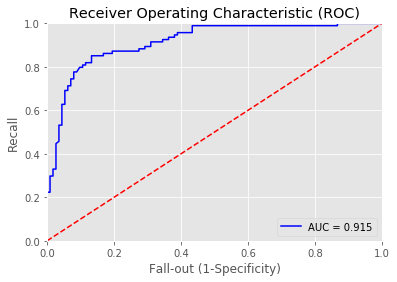
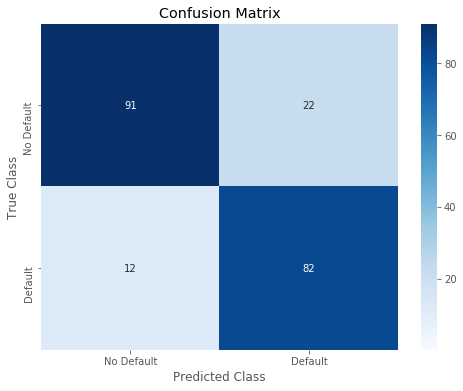
precision recall f1-score support
class 0 0.88 0.81 0.84 113
class 1 0.79 0.87 0.83 94
micro avg 0.84 0.84 0.84 207
macro avg 0.84 0.84 0.84 207
weighted avg 0.84 0.84 0.84 207LR
1 | from sklearn.linear_model import LogisticRegression |
2 | from sklearn.feature_selection import RFE |
先不做特征处理,不做标准化,直接进行拟合
参数选择:
正则化:l1,l2
正则化参数:C
样本权重:平衡权重,均匀权重
1 | lr = LogisticRegression() |
2 | penalty = ['l1','l2'] |
3 | C = [1,0.3,0.1,0.03,0.01] |
4 | class_weight = ['balanced',None] |
5 | param_gridknn = dict(penalty=penalty,C=C,class_weight=class_weight) |
6 | gridLR = GridSearchCV(lr, param_gridknn, cv=10, scoring='roc_auc',verbose=1, n_jobs=-1) |
7 | gridLR.fit(train_x1,train_y1) |
8 | print('best params are:',str(gridLR.best_params_)) |
Fitting 10 folds for each of 20 candidates, totalling 200 fits
[Parallel(n_jobs=-1)]: Using backend LokyBackend with 2 concurrent workers.
[Parallel(n_jobs=-1)]: Done 176 tasks | elapsed: 5.0s
best params are: {'C': 1, 'class_weight': None, 'penalty': 'l1'}
[Parallel(n_jobs=-1)]: Done 200 out of 200 | elapsed: 5.3s finished
/usr/local/lib/python3.6/dist-packages/sklearn/linear_model/logistic.py:433: FutureWarning: Default solver will be changed to 'lbfgs' in 0.22. Specify a solver to silence this warning.
FutureWarning)1 | logreg = LogisticRegression(class_weight=None,C=1,penalty='l1') |
2 | logreg.fit(train_x1, train_y1) |
3 | |
4 | predictions_LogReg_prob = logreg.predict_proba(test_x1) |
5 | predictions_LogReg_prob = predictions_LogReg_prob[:,1] |
6 | predictions_LogReg_01 = logreg.predict(test_x1) |
7 | |
8 | acc_logit = accuracy_score(test_y1, predictions_LogReg_01) |
9 | print('Overall accuracy of Logistic Regression model:', acc_logit) |
10 | |
11 | print_roc_curve(test_y1, predictions_LogReg_prob) |
12 | r = print_confusion_matrix(test_y1, predictions_LogReg_01) |
13 | RESULT['lr'] = r |
/usr/local/lib/python3.6/dist-packages/sklearn/linear_model/logistic.py:433: FutureWarning: Default solver will be changed to 'lbfgs' in 0.22. Specify a solver to silence this warning.
FutureWarning)
Overall accuracy of Logistic Regression model: 0.8647342995169082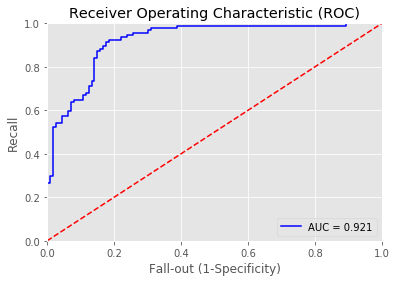
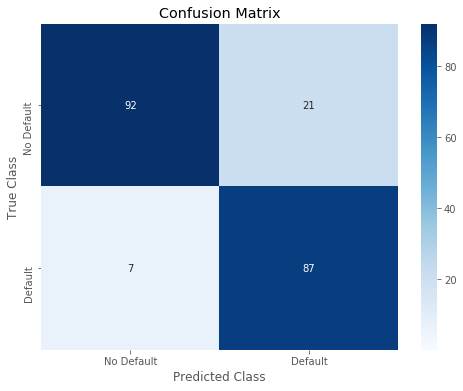
precision recall f1-score support
class 0 0.93 0.81 0.87 113
class 1 0.81 0.93 0.86 94
micro avg 0.86 0.86 0.86 207
macro avg 0.87 0.87 0.86 207
weighted avg 0.87 0.86 0.86 207对’A3’, ‘A7’, ‘A10’, ‘A13’, ‘A14’连续变量离散化后(全部等宽离散化为4组),进行拟合
之所以选择’A3’, ‘A7’, ‘A10’, ‘A13’, ‘A14’使因为这些列的数据分布很不均匀,而A2较均匀。
1 | df = pd.read_table('australian.dat',sep=' ', header=None) |
2 | df.columns = ['A1', 'A2', 'A3', 'A4', 'A5', 'A6', 'A7', 'A8', 'A9', 'A10', 'A11', 'A12', 'A13', 'A14', 'Default'] |
3 | df1 = df |
4 | for each in ['A3', 'A7', 'A10', 'A13', 'A14']: |
5 | df1[each] = pd.cut(df1[each],bins=4,labels=['a','b','c','d']) |
6 | df1 = pd.get_dummies(df1) |
7 | train_df1, test_df1 = train_test_split(df1, test_size = 0.3, random_state= 2019) |
8 | train_y1 = train_df1.Default |
9 | test_y1 = test_df1.Default |
10 | train_x1 = train_df1.drop(['Default'], axis = 1) |
11 | test_x1 = test_df1.drop(['Default'], axis = 1) |
/usr/local/lib/python3.6/dist-packages/ipykernel_launcher.py:1: FutureWarning: read_table is deprecated, use read_csv instead.
"""Entry point for launching an IPython kernel.1 | lr = LogisticRegression() |
2 | penalty = ['l1','l2'] |
3 | C = [1,0.3,0.1,0.03,0.01] |
4 | class_weight = ['balanced',None] |
5 | param_gridknn = dict(penalty=penalty,C=C,class_weight=class_weight) |
6 | gridLR = GridSearchCV(lr, param_gridknn, cv=10, scoring='roc_auc',verbose=1, n_jobs=-1) |
7 | gridLR.fit(train_x1,train_y1) |
8 | print('best params are:',str(gridLR.best_params_)) |
Fitting 10 folds for each of 20 candidates, totalling 200 fits
[Parallel(n_jobs=-1)]: Done 45 tasks | elapsed: 6.1s
[Parallel(n_jobs=-1)]: Done 200 out of 200 | elapsed: 6.7s finished
best params are: {'C': 1, 'class_weight': None, 'penalty': 'l1'}1 | logreg = LogisticRegression(class_weight=None,C=1,penalty='l1') |
2 | logreg.fit(train_x1, train_y1) |
3 | |
4 | predictions_LogReg_prob = logreg.predict_proba(test_x1) |
5 | predictions_LogReg_prob = predictions_LogReg_prob[:,1] |
6 | predictions_LogReg_01 = logreg.predict(test_x1) |
7 | |
8 | acc_logit = accuracy_score(test_y1, predictions_LogReg_01) |
9 | print('Overall accuracy of Logistic Regression model:', acc_logit) |
10 | |
11 | print_roc_curve(test_y1, predictions_LogReg_prob) |
12 | r = print_confusion_matrix(test_y1, predictions_LogReg_01) |
13 | RESULT['lr1'] = r |
/usr/local/lib/python3.6/dist-packages/sklearn/linear_model/logistic.py:433: FutureWarning: Default solver will be changed to 'lbfgs' in 0.22. Specify a solver to silence this warning.
FutureWarning)
Overall accuracy of Logistic Regression model: 0.855072463768116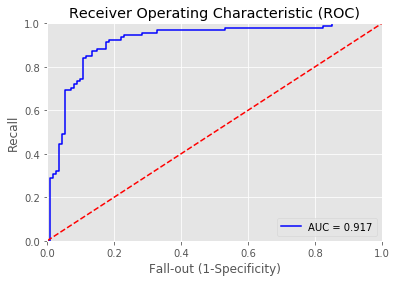
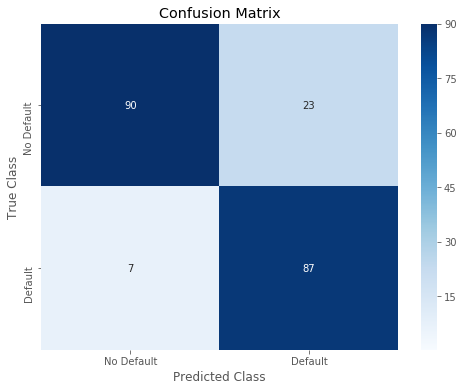
precision recall f1-score support
class 0 0.93 0.80 0.86 113
class 1 0.79 0.93 0.85 94
micro avg 0.86 0.86 0.86 207
macro avg 0.86 0.86 0.86 207
weighted avg 0.87 0.86 0.86 207特征离散化和不离散化结果几乎一致,没有特别的差距,应该是数据集的特点
Decision Tree :Cart
1 | from sklearn.tree import DecisionTreeClassifier |
参数选择:
树深:max_depth
1 | dt = DecisionTreeClassifier() |
2 | max_depth = [2, 4, 8, 16, None] |
3 | param_griddt = dict(max_depth = max_depth) |
4 | gridKNN = GridSearchCV(dt, param_griddt, cv=10, scoring='roc_auc',verbose=1, n_jobs=-1) |
5 | gridKNN.fit(train_x,train_y) |
6 | print('best params are:',str(gridKNN.best_params_)) |
Fitting 10 folds for each of 5 candidates, totalling 50 fits
best params are: {'max_depth': 2}
[Parallel(n_jobs=-1)]: Done 50 out of 50 | elapsed: 5.7s finished1 | dt = DecisionTreeClassifier(max_depth=2) |
2 | dt.fit(train_x, train_y) |
3 | |
4 | predictions_dt_prob = dt.predict(test_x) |
5 | predictions_dt_01 = np.where(predictions_dt_prob > 0.5, 1, 0) |
6 | |
7 | acc_dt = accuracy_score(test_y, predictions_dt_01) |
8 | print('Overall accuracy of Decision Tree model:', acc_dt) |
9 | |
10 | print_roc_curve(test_y, predictions_dt_prob) |
11 | r = print_confusion_matrix(test_y, predictions_dt_01) |
12 | RESULT['DT'] = r |
Overall accuracy of Decision Tree model: 0.8405797101449275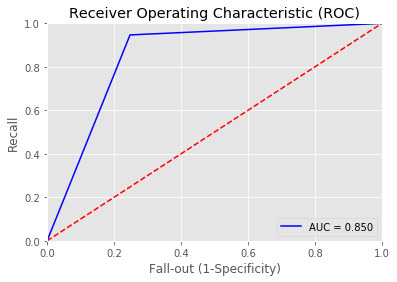
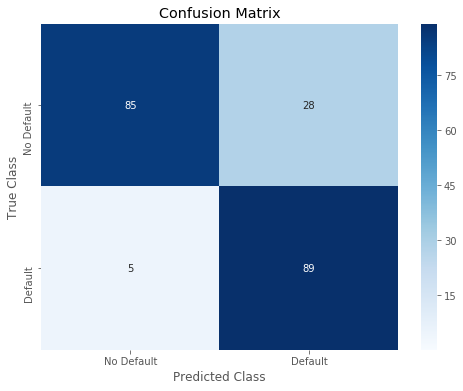
precision recall f1-score support
class 0 0.94 0.75 0.84 113
class 1 0.76 0.95 0.84 94
micro avg 0.84 0.84 0.84 207
macro avg 0.85 0.85 0.84 207
weighted avg 0.86 0.84 0.84 207SVM
1 | from sklearn.svm import SVC |
参数选择:
核函数:多项式,sigmoid,高斯核函数,线性核函数,线性核函数
gamma:核函数系数
C:正则项系数
1 | svm = SVC() |
2 | param_gridsvm = [{'kernel': ['poly', 'rbf', 'sigmoid'], 'gamma': [0.001,0.003,0.01,0.03,0.1,1], |
3 | 'C': [0.01,0.03,0.1,1, 3,10,30, 100,300, 1000]}, |
4 | {'kernel': ['linear'], 'C': [0.01,0.03,0.1,1, 3,10,30, 100,300, 1000]}] |
5 | gridsvm = GridSearchCV(svm, param_gridsvm, cv=10, scoring='roc_auc',verbose=1, n_jobs=-1) |
6 | gridsvm.fit(train_x,train_y) |
7 | print('best params are:',str(gridsvm.best_params_)) |
Fitting 10 folds for each of 190 candidates, totalling 1900 fits
[Parallel(n_jobs=-1)]: Using backend LokyBackend with 2 concurrent workers.
[Parallel(n_jobs=-1)]: Done 256 tasks | elapsed: 6.3s
[Parallel(n_jobs=-1)]: Done 1156 tasks | elapsed: 25.0s
best params are: {'C': 0.1, 'gamma': 0.1, 'kernel': 'poly'}
[Parallel(n_jobs=-1)]: Done 1900 out of 1900 | elapsed: 1.9min finished
/usr/local/lib/python3.6/dist-packages/sklearn/model_selection/_search.py:841: DeprecationWarning: The default of the `iid` parameter will change from True to False in version 0.22 and will be removed in 0.24. This will change numeric results when test-set sizes are unequal.
DeprecationWarning)1 | svm = SVC(C=0.1, gamma=0.1, kernel='poly') |
2 | svm.fit(train_x, train_y) |
3 | |
4 | predictions_svm_prob = svm.predict(test_x) |
5 | predictions_svm_01 = np.where(predictions_svm_prob > 0.5, 1, 0) |
6 | |
7 | acc_svm = accuracy_score(test_y, predictions_svm_01) |
8 | print('Overall accuracy of SVM model:', acc_knn) |
9 | |
10 | print_roc_curve(test_y, predictions_svm_prob) |
11 | r = print_confusion_matrix(test_y, predictions_svm_01) |
12 | RESULT['SVM'] = r |
Overall accuracy of SVM model: 0.8647342995169082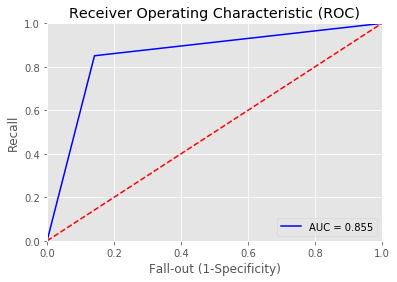
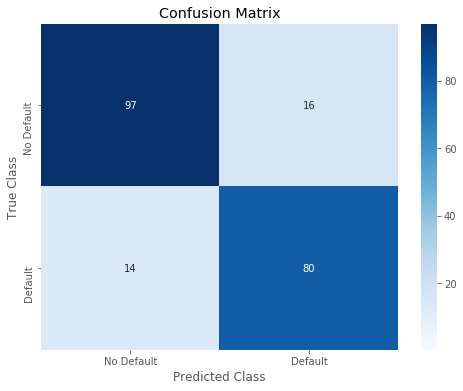
precision recall f1-score support
class 0 0.87 0.86 0.87 113
class 1 0.83 0.85 0.84 94
micro avg 0.86 0.86 0.86 207
macro avg 0.85 0.85 0.85 207
weighted avg 0.86 0.86 0.86 207RF
1 | from sklearn.ensemble import RandomForestClassifier |
参数选择:
n_estimaors: 森林中树的个数
max_depth: 最大树深
1 | rf = RandomForestClassifier() |
2 | n_estimators = list(range(5,101,10)) |
3 | max_depth = list(range(2,20,2)) |
4 | param_gridrf = dict(n_estimators = n_estimators, max_depth=max_depth) |
5 | gridRF = GridSearchCV(rf, param_gridrf, cv=10, scoring='roc_auc',verbose=1, n_jobs=-1) |
6 | gridRF.fit(train_x,train_y) |
7 | print('best params are:',str(gridRF.best_params_)) |
Fitting 10 folds for each of 90 candidates, totalling 900 fits
[Parallel(n_jobs=-1)]: Done 48 tasks | elapsed: 7.2s
[Parallel(n_jobs=-1)]: Done 348 tasks | elapsed: 18.9s
[Parallel(n_jobs=-1)]: Done 848 tasks | elapsed: 37.3s
best params are: {'max_depth': 10, 'n_estimators': 95}
[Parallel(n_jobs=-1)]: Done 900 out of 900 | elapsed: 40.0s finished1 | rf = RandomForestClassifier(n_estimators=95, max_depth=10) |
2 | rf.fit(train_x, train_y) |
3 | |
4 | predictions_rf_prob = rf.predict(test_x) |
5 | predictions_rf_01 = np.where(predictions_rf_prob > 0.5, 1, 0) |
6 | |
7 | acc_rf = accuracy_score(test_y, predictions_rf_01) |
8 | print('Overall accuracy of Random Forest model:', acc_rf) |
9 | |
10 | print_roc_curve(test_y, predictions_rf_prob) |
11 | r = print_confusion_matrix(test_y, predictions_rf_01) |
12 | RESULT['RF'] = r |
Overall accuracy of Random Forest model: 0.855072463768116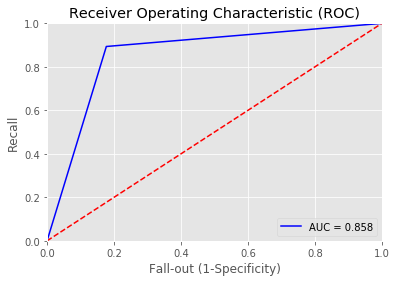
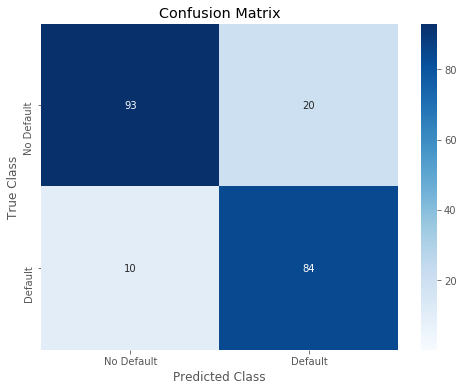
precision recall f1-score support
class 0 0.90 0.82 0.86 113
class 1 0.81 0.89 0.85 94
micro avg 0.86 0.86 0.86 207
macro avg 0.86 0.86 0.85 207
weighted avg 0.86 0.86 0.86 207XGBoost
1 | import xgboost as xgb |
参数选择:
学习率
弱学习器的个数
最大树深
样本采样比列
叶子权重正则系数
叶子个数正则系数
1 | XGB = xgb.XGBClassifier() |
2 | param_gridxgb = dict( |
3 | learning_rate = [1,0.1,0.01], |
4 | n_estimators = [8,16,32,64], |
5 | max_depth = [2,4,6,8,10], |
6 | subsample = [1,0.8,0.6], |
7 | reg_alpha = [1,0.1,0], |
8 | reg_lambda = [1,0.1,0] |
9 | ) |
10 | gridxgb = GridSearchCV(XGB, param_gridxgb, cv=5, scoring='roc_auc',verbose=1, n_jobs=-1) |
11 | gridxgb.fit(train_x,train_y) |
12 | print('best params are:',str(gridxgb.best_params_)) |
Fitting 5 folds for each of 1620 candidates, totalling 8100 fits
[Parallel(n_jobs=-1)]: Using backend LokyBackend with 2 concurrent workers.
[Parallel(n_jobs=-1)]: Done 281 tasks | elapsed: 4.6s
[Parallel(n_jobs=-1)]: Done 1481 tasks | elapsed: 37.6s
[Parallel(n_jobs=-1)]: Done 3481 tasks | elapsed: 1.6min
[Parallel(n_jobs=-1)]: Done 5277 tasks | elapsed: 2.7min
[Parallel(n_jobs=-1)]: Done 7077 tasks | elapsed: 3.8min
best params are: {'learning_rate': 0.1, 'max_depth': 4, 'n_estimators': 32, 'reg_alpha': 0, 'reg_lambda': 0.1, 'subsample': 0.6}
[Parallel(n_jobs=-1)]: Done 8100 out of 8100 | elapsed: 4.5min finished1 | gridxgb.best_params_ |
{'learning_rate': 0.1,
'max_depth': 4,
'n_estimators': 32,
'reg_alpha': 0,
'reg_lambda': 0.1,
'subsample': 0.6}1 | % matplotlib inline |
2 | xgdmat = xgb.DMatrix(train_x, train_y) # Create our DMatrix to make XGBoost more efficient |
3 | testdmat = xgb.DMatrix(test_x) |
4 | # final_gb = xgb.train(gridxgb.best_params_, xgdmat) |
5 | |
6 | # predictions_xgb_prob = final_gb.predict(testdmat) |
7 | # predictions_xgb_01 = np.where(predictions_xgb_prob > 0.5, 1, 0) #Turn probability to 0-1 binary output |
8 | |
9 | # xgb.plot_importance(final_gb) |
10 | |
11 | trainxdmat = xgb.DMatrix(train_x) # Create our DMatrix to make XGBoost more efficient |
12 | trainydmat = xgb.DMatrix(train_y) # Create our DMatrix to make XGBoost more efficient |
13 | XGB = xgb.XGBClassifier(learning_rate=0.1, |
14 | max_depth=4, |
15 | n_estimators= 32, |
16 | reg_alpha= 0, |
17 | reg_lambda= 0.1, |
18 | subsample= 0.6, |
19 | ) |
20 | XGB.fit(train_x.values,train_y.values) |
21 | print('1') |
22 | |
23 | predictions_xgb_prob = XGB.predict(test_x.values) |
24 | predictions_xgb_01 = np.where(predictions_xgb_prob > 0.5, 1, 0) #Turn probability to 0-1 binary output |
/usr/local/lib/python3.6/dist-packages/xgboost/core.py:587: FutureWarning: Series.base is deprecated and will be removed in a future version
if getattr(data, 'base', None) is not None and \
/usr/local/lib/python3.6/dist-packages/xgboost/core.py:588: FutureWarning: Series.base is deprecated and will be removed in a future version
data.base is not None and isinstance(data, np.ndarray) \
1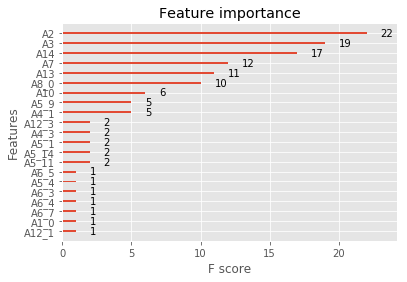
1 | acc_lgbm = accuracy_score(test_y,predictions_xgb_01) |
2 | print('Overall accuracy of Light GBM model:', acc_lgbm) |
3 | |
4 | print_roc_curve(test_y, predictions_rf_prob) |
5 | r = print_confusion_matrix(test_y, predictions_rf_01) |
6 | RESULT['XGB'] = r |
Overall accuracy of Light GBM model: 0.8647342995169082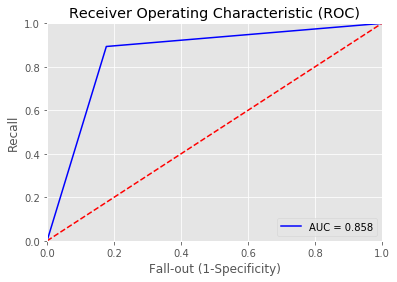
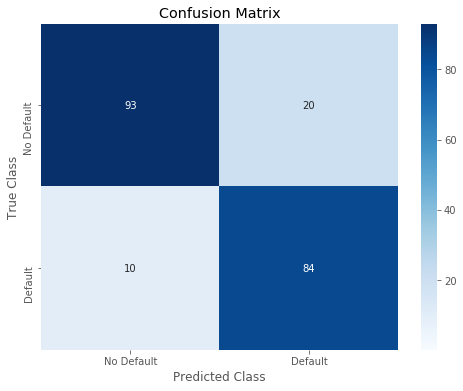
precision recall f1-score support
class 0 0.90 0.82 0.86 113
class 1 0.81 0.89 0.85 94
micro avg 0.86 0.86 0.86 207
macro avg 0.86 0.86 0.85 207
weighted avg 0.86 0.86 0.86 207LightGBM(GBDT)
先单纯使用GBDT
1 | import lightgbm as lgb |
1 | train_data=lgb.Dataset(train_x,label=train_y) |
2 | |
3 | params = {'boosting_type': 'gbdt', |
4 | 'max_depth' : -1, |
5 | 'objective': 'binary', |
6 | 'nthread': 5, # Updated from nthread |
7 | 'num_leaves': 64, |
8 | 'learning_rate': 0.05, |
9 | 'max_bin': 512, |
10 | 'subsample_for_bin': 200, |
11 | 'subsample': 1, |
12 | 'subsample_freq': 1, |
13 | 'colsample_bytree': 0.8, |
14 | 'reg_alpha': 5, |
15 | 'reg_lambda': 10, |
16 | 'min_split_gain': 0.5, |
17 | 'min_child_weight': 1, |
18 | 'min_child_samples': 5, |
19 | 'scale_pos_weight': 1, |
20 | 'num_class' : 1, |
21 | 'metric' : 'binary_error' |
22 | } |
23 | |
24 | gridParams = { |
25 | 'learning_rate': [1,0.1,0.01], |
26 | 'n_estimators': [8,16,32,64], |
27 | 'num_leaves': [50,100,150,200,250,300], |
28 | 'boosting_type' : ['gbdt'], |
29 | 'objective' : ['binary'], |
30 | 'colsample_bytree' : [1,0.8,0.6], |
31 | 'subsample' : [1,0.8,0.6], |
32 | 'reg_alpha' : [10,3,1, 0.1], |
33 | 'reg_lambda' : [10,3,1, 0.1], |
34 | } |
35 | |
36 | mdl = lgb.LGBMClassifier(boosting_type= 'gbdt', |
37 | objective = 'binary', |
38 | n_jobs = 5, # Updated from 'nthread' |
39 | silent = True, |
40 | max_depth = params['max_depth'], |
41 | max_bin = params['max_bin'], |
42 | subsample_for_bin = params['subsample_for_bin'], |
43 | subsample = params['subsample'], |
44 | subsample_freq = params['subsample_freq'], |
45 | min_split_gain = params['min_split_gain'], |
46 | min_child_weight = params['min_child_weight'], |
47 | min_child_samples = params['min_child_samples'], |
48 | scale_pos_weight = params['scale_pos_weight']) |
49 | |
50 | mdl.get_params().keys() |
dict_keys(['boosting_type', 'class_weight', 'colsample_bytree', 'importance_type', 'learning_rate', 'max_depth', 'min_child_samples', 'min_child_weight', 'min_split_gain', 'n_estimators', 'n_jobs', 'num_leaves', 'objective', 'random_state', 'reg_alpha', 'reg_lambda', 'silent', 'subsample', 'subsample_for_bin', 'subsample_freq', 'max_bin', 'scale_pos_weight'])这里用的4折交叉验证,因为参数实在太多,跑不动,太慢了,其实用10折比较好
后来把正则项系数改大了,因为后面发现过拟合了,但是还没跑,就用原来的参数吧;或者你有时间就直接运行一下就可以
1 | grid = GridSearchCV(mdl, gridParams, verbose=1, cv=4, n_jobs=-1) |
2 | grid.fit(train_x, train_y) |
3 | |
4 | print(grid.best_params_) |
5 | print(grid.best_score_) |
1 | % matplotlib inline |
2 | best_p = {'boosting_type': 'gbdt', 'colsample_bytree': 0.6, 'learning_rate': 1, 'n_estimators': 16, 'num_leaves': 50, 'objective': 'binary', 'reg_alpha': 0.01, 'reg_lambda': 1, 'subsample': 1} |
3 | lgbm = lgb.train(best_p,#grid.best_params_, |
4 | train_data, |
5 | 2500, |
6 | verbose_eval= 4 |
7 | ) |
8 | |
9 | predictions_lgbm_prob = lgbm.predict(test_x) |
10 | predictions_lgbm_01 = np.where(predictions_lgbm_prob > 0.5, 1, 0) |
11 | |
12 | lgb.plot_importance(lgbm, max_num_features=21, importance_type='split') |
/usr/local/lib/python3.6/dist-packages/lightgbm/engine.py:118: UserWarning: Found `n_estimators` in params. Will use it instead of argument
warnings.warn("Found `{}` in params. Will use it instead of argument".format(alias))
<matplotlib.axes._subplots.AxesSubplot at 0x7ff7884feb00>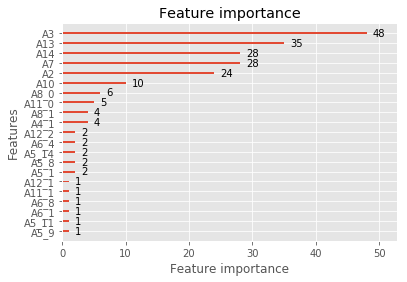
1 | acc_lgbm = accuracy_score(test_y,predictions_lgbm_01) |
2 | print('Overall accuracy of Light GBM model:', acc_lgbm) |
3 | print_roc_curve(test_y, predictions_lgbm_prob) |
4 | r = print_confusion_matrix(test_y, predictions_lgbm_01) |
5 | RESULT['GBDT'] = r |
Overall accuracy of Light GBM model: 0.8695652173913043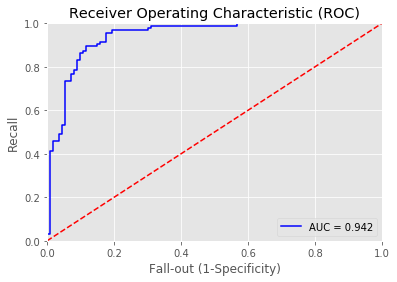
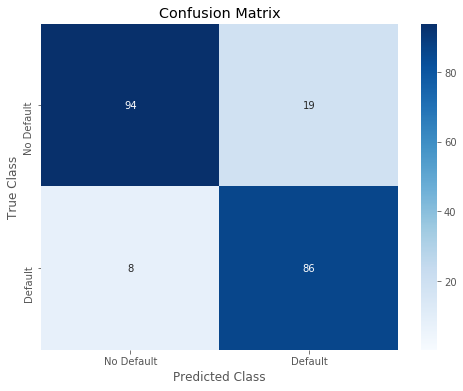
precision recall f1-score support
class 0 0.92 0.83 0.87 113
class 1 0.82 0.91 0.86 94
micro avg 0.87 0.87 0.87 207
macro avg 0.87 0.87 0.87 207
weighted avg 0.88 0.87 0.87 207GBDT+LR
1.通过GBDT进行特征转换(为了发现有效的特征和特征组合): 判断样本落在哪个叶子节点上,每个叶子节点作为lr的一维特征,通过遍历树,就得到了该样本对应的所有LR特征。构造的新特征向量是取值onehot化的
2.转换得到新的特征后,用lr分类
继续使用上面GBDT模型,得到新的特征
1 | y_pred = lgbm.predict(train_x, pred_leaf=True) |
2 | |
3 | # y_pred = final_gb.predict(testdmat,pred_leaf=True) |
4 | |
5 | y_pred.shape |
6 | num_leaf = max([max(each) for each in y_pred]) |
7 | num_leaf |
171 | print('Writing transformed training data') |
2 | # num_leaf = grid.best_params_['num_leaves'] |
3 | transformed_training_matrix = np.zeros([len(y_pred), len(y_pred[0]) * num_leaf], |
4 | dtype=np.int64) # N * num_tress * num_leafs |
5 | for i in range(0, len(y_pred)): |
6 | temp = np.arange(len(y_pred[0])) * num_leaf + np.array(y_pred[i]) |
7 | transformed_training_matrix[i][temp] += 1 |
Writing transformed training data1 | y_pred = lgbm.predict(test_x, pred_leaf=True) |
2 | print('Writing transformed testing data') |
3 | transformed_testing_matrix = np.zeros([len(y_pred), len(y_pred[0]) * num_leaf], dtype=np.int64) |
4 | for i in range(0, len(y_pred)): |
5 | temp = np.arange(len(y_pred[0])) * num_leaf + np.array(y_pred[i]) |
6 | transformed_testing_matrix[i][temp] += 1 |
Writing transformed testing data1 | transformed_testing_matrix.shape,transformed_training_matrix.shape |
((207, 272), (483, 272))训练集和测试集新的特征的维度
将GBDT换成XGoost,通过XGboost进行特征转换
1 | y_pred = XGB.apply(train_x.values) |
2 | num_leaf = max([max(each) for each in y_pred]) |
3 | y_pred[13] |
array([23, 25, 23, 17, 21, 24, 25, 22, 25, 6, 21, 22, 21, 19, 14, 12, 23,
12, 12, 22, 7, 14, 22, 11, 13, 14, 19, 11, 16, 12, 21, 16],
dtype=int32)1 | |
2 | |
3 | print('Writing transformed training data') |
4 | # num_leaf = grid.best_params_['num_leaves'] |
5 | transformed_training_matrix = np.zeros([len(y_pred), len(y_pred[0]) * num_leaf], |
6 | dtype=np.int64) # N * num_tress * num_leafs |
7 | for i in range(0, len(y_pred)): |
8 | temp = np.arange(len(y_pred[0])) * num_leaf + np.array(y_pred[i]) |
9 | transformed_training_matrix[i][temp] += 1 |
10 | |
11 | y_pred = XGB.apply(test_x.values) |
12 | print('Writing transformed testing data') |
13 | transformed_testing_matrix = np.zeros([len(y_pred), len(y_pred[0]) * num_leaf], dtype=np.int64) |
14 | for i in range(0, len(y_pred)): |
15 | temp = np.arange(len(y_pred[0])) * num_leaf + np.array(y_pred[i]) |
16 | transformed_testing_matrix[i][temp] += 1 |
17 | |
18 | transformed_testing_matrix.shape,transformed_training_matrix.shape |
Writing transformed training data
Writing transformed testing data
((207, 832), (483, 832))用新的特征进行lr分类,先做参数选择
1 | lr = LogisticRegression() |
2 | penalty = ['l1','l2'] |
3 | C = [10,3,1,0.3,0.1,0.03,0.01] |
4 | class_weight = ['balanced',None] |
5 | param_gridknn = dict(penalty=penalty,C=C,class_weight=class_weight) |
6 | gridLR = GridSearchCV(lr, param_gridknn, cv=10, scoring='roc_auc',verbose=1, n_jobs=-1) |
7 | gridLR.fit(transformed_training_matrix,train_y) |
8 | print('best params are:',str(gridLR.best_params_)) |
Fitting 10 folds for each of 28 candidates, totalling 280 fits
[Parallel(n_jobs=-1)]: Using backend LokyBackend with 2 concurrent workers.
best params are: {'C': 0.3, 'class_weight': 'balanced', 'penalty': 'l2'}
[Parallel(n_jobs=-1)]: Done 280 out of 280 | elapsed: 5.3s finished
/usr/local/lib/python3.6/dist-packages/sklearn/linear_model/logistic.py:433: FutureWarning: Default solver will be changed to 'lbfgs' in 0.22. Specify a solver to silence this warning.
FutureWarning)1 | logreg = LogisticRegression(class_weight='balanced',C=0.3,penalty='l2') |
2 | logreg.fit(transformed_training_matrix,train_y) |
3 | |
4 | predictions_LogReg_prob = logreg.predict_proba(transformed_testing_matrix) |
5 | predictions_LogReg_prob = predictions_LogReg_prob[:,1] |
6 | predictions_LogReg_01 = logreg.predict(transformed_testing_matrix) |
7 | |
8 | acc_logit = accuracy_score(test_y, predictions_LogReg_01) |
9 | print('Overall accuracy of Logistic Regression model:', acc_logit) |
10 | |
11 | print_roc_curve(test_y, predictions_LogReg_prob) |
12 | r = print_confusion_matrix(test_y, predictions_LogReg_01) |
13 | RESULT['XGB_lr'] = r |
/usr/local/lib/python3.6/dist-packages/sklearn/linear_model/logistic.py:433: FutureWarning: Default solver will be changed to 'lbfgs' in 0.22. Specify a solver to silence this warning.
FutureWarning)
Overall accuracy of Logistic Regression model: 0.8599033816425121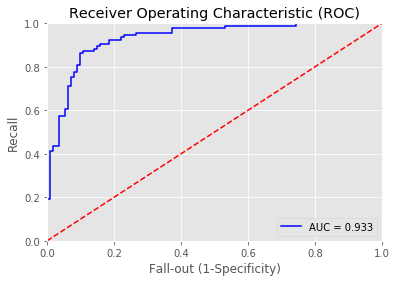
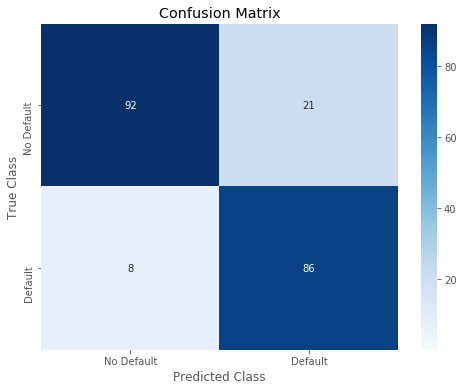
precision recall f1-score support
class 0 0.92 0.81 0.86 113
class 1 0.80 0.91 0.86 94
micro avg 0.86 0.86 0.86 207
macro avg 0.86 0.86 0.86 207
weighted avg 0.87 0.86 0.86 207结果汇总
1 | model_name = RESULT.keys() |
2 | model_preformance = RESULT.values() |
3 | preformance1 = ['recall','precision'] |
4 | preformance2 = ['acc','f1','auc'] |
5 | xx = list(range(len(model_name))) |
6 | plt.rcParams['figure.figsize'] = (8.0, 4.0) |
7 | for i,each in enumerate(preformance1): |
8 | plt.plot(xx,[each[i] for each in model_preformance]) |
9 | plt.title('model compare') |
10 | plt.xlabel('model name') |
11 | plt.ylabel('performance') |
12 | plt.xticks(xx,model_name) |
13 | plt.legend(preformance1) |
<matplotlib.legend.Legend at 0x7ff754f29dd8>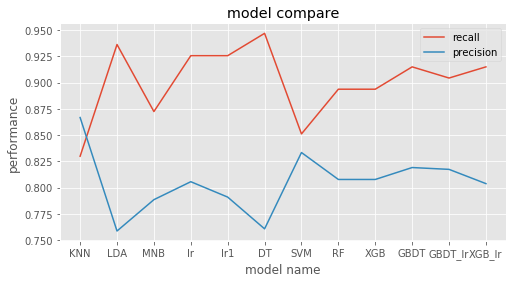
1 | for i,each in enumerate(preformance2): |
2 | plt.plot(xx,[each[i] for each in model_preformance]) |
3 | plt.title('model compare') |
4 | plt.xlabel('model name') |
5 | plt.ylabel('performance') |
6 | plt.xticks(xx,model_name) |
7 | plt.legend(preformance2) |
<matplotlib.legend.Legend at 0x7ff754f6ecf8>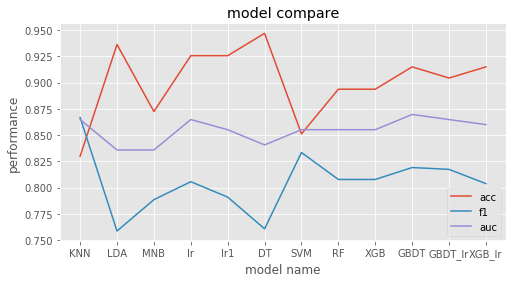
1 | model_name = RESULT.keys() |
2 | model_preformance = RESULT.values() |
3 | preformance1 = ['recall','precision'] |
4 | preformance2 = ['acc','f1','auc'] |
5 | preformance = preformance1 + preformance2 |
6 | xx = list(range(len(model_name))) |
7 | plt.rcParams['figure.figsize'] = (10.0, 6.0) |
8 | for i,each in enumerate(preformance): |
9 | plt.plot(xx,[each[i] for each in model_preformance]) |
10 | plt.title('model compare') |
11 | plt.xlabel('model name') |
12 | plt.ylabel('performance') |
13 | plt.xticks(xx,model_name) |
14 | plt.legend(preformance) |
<matplotlib.legend.Legend at 0x7ff754c2b0b8>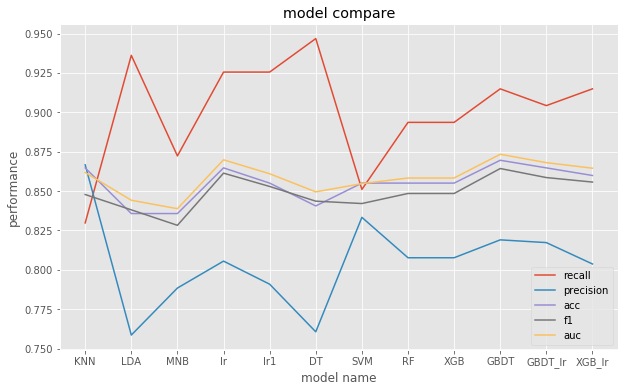
可以着重展示一下SVM,LR,GBDT,GBDT+LR,XGBoost+LR ,因为参数比较多,调参过程选择多一些
后面三个模型逻辑是这样的 :
LR 首先连续变量不做离散化直接拟合,之后选择一些连续变量做离散化再做拟合,发现模型表现没有提升,
于是想试试更多特征的表现,
于是通过GBDT(以每个叶子节点作为一个特征)进行特征转换,组合得到更多的特征,进行lr分类.
最后将GBDT换成XGboost做尝试
再使用GBDT或XGboost特征后,lr相比之前有了较大的改善
但是相比GDBT本身却下降了,可能因为数据量的问题,出现了过拟合
XGboost,有小幅上升
进行探索,查看GBDT和XGBoost在训练集上的表现,发现GBDT已经完全拟合了训练集,确实存在过拟合现象,而XGBoost过拟合不严重
1 | predictions_lgbm_prob = XGB.predict(train_x.values) |
2 | predictions_lgbm_01 = np.where(predictions_lgbm_prob > 0.5, 1, 0) |
3 | acc_lgbm = accuracy_score(train_y,predictions_lgbm_01) |
4 | print('Overall accuracy of Light GBM model:', acc_lgbm) |
5 | print_roc_curve(train_y, predictions_lgbm_prob) |
6 | r = print_confusion_matrix(train_y, predictions_lgbm_01) |
Overall accuracy of Light GBM model: 0.9420289855072463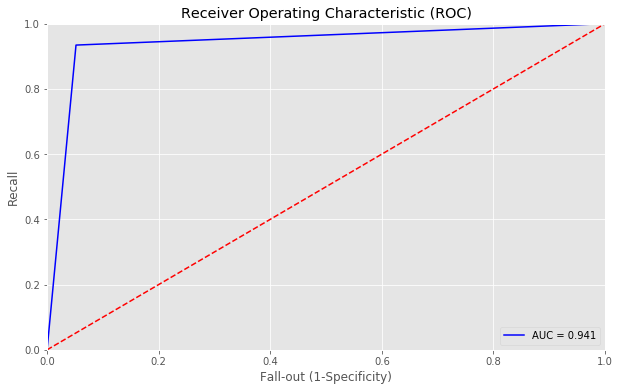
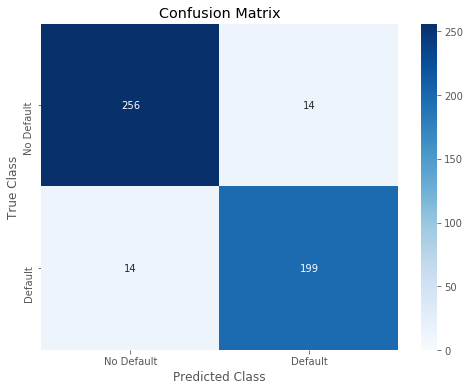
precision recall f1-score support
class 0 0.95 0.95 0.95 270
class 1 0.93 0.93 0.93 213
micro avg 0.94 0.94 0.94 483
macro avg 0.94 0.94 0.94 483
weighted avg 0.94 0.94 0.94 4831 | predictions_lgbm_prob = lgbm.predict(train_x.values) |
2 | predictions_lgbm_01 = np.where(predictions_lgbm_prob > 0.5, 1, 0) |
3 | acc_lgbm = accuracy_score(train_y,predictions_lgbm_01) |
4 | print('Overall accuracy of Light GBM model:', acc_lgbm) |
5 | print_roc_curve(train_y, predictions_lgbm_prob) |
6 | r = print_confusion_matrix(train_y, predictions_lgbm_01) |
Overall accuracy of Light GBM model: 0.9979296066252588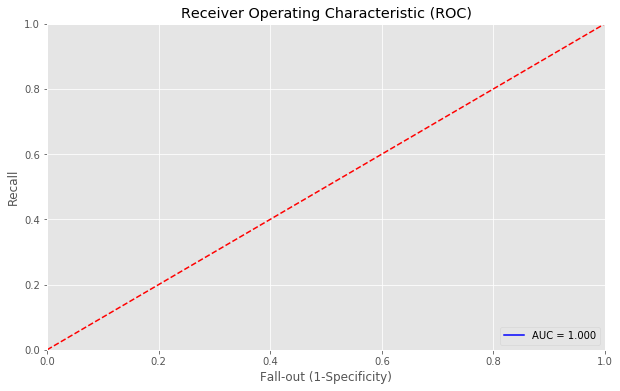
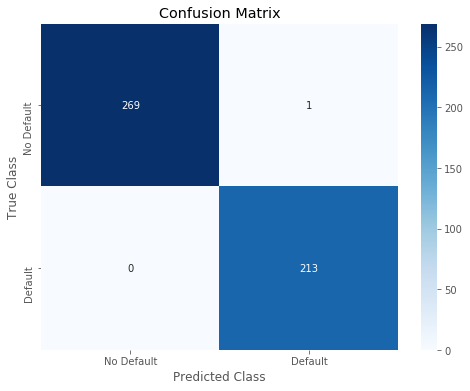
precision recall f1-score support
class 0 1.00 1.00 1.00 270
class 1 1.00 1.00 1.00 213
micro avg 1.00 1.00 1.00 483
macro avg 1.00 1.00 1.00 483
weighted avg 1.00 1.00 1.00 483
